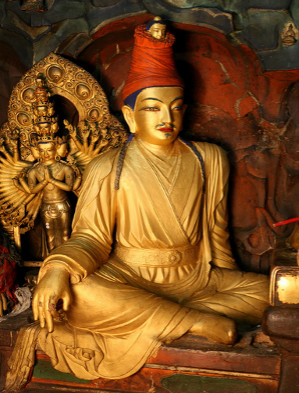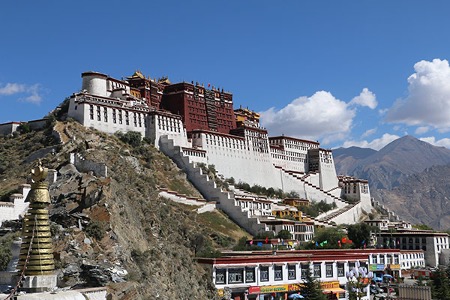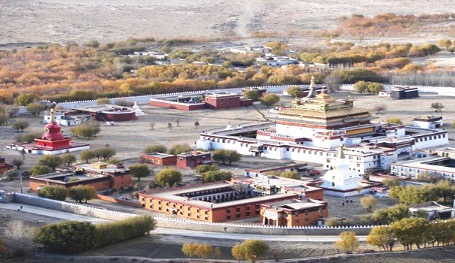When the Buddha passed away, his teachings were collected together by a council of senior disciples. As a result of this, the precious teachings of Dharma were introduced to many countries.

Prior to the introduction of Buddhism to Tibet, it had its own shamanistic religion known as ‘Bon’. In the 7th century, Tibet saw the first introduction of Buddhism through the visit of some prominent Indian Panditas, who were invited by early Tibetan kings. Early Tibetan kings were keen to promote Buddhism and were regarded as emanations of bodhisattvas.
The first prominent Dharma King Songsten Gampo (617-650) is believed to be an emanation of Avalokiteshvara. He married Chinese, Nepalese and Tibetan princesses. The Chinese Princess Wenshing Kongjo brought with her the Jowo Shakyamuni Buddha statue, the main statue housed inside the Jokhang Temple in Lhasa. The Nepalese Princess Bhrikuti brought with her the Akshobya statue, which is now inside the Ramoche temple in Lhasa.
King Songtsen Gampo also sent Thonmi Sambhota to India to study Sanskrit and it was he who invented the Tibetan script to translate Buddhist texts into Tibetan. The King founded the Tradruk Dolma Lhakhang temple in Yarlung Valley and built a palace on Marpori (Red Hill), which predates the Potala palace.

The second great Dharma King Trisong Deutsen (740-798) is regarded as an emanation of Manjushri. He made a great effort to increase the spread of Buddhist activities, and invited Shantarakshita, who was one of the more prominent Indian Buddhist monks to come to Tibet. Shantarakshita, who is also known in Tibetan as ‘Khenchen Bodhisattva’ was the first Indian Buddhist abbot to ordain Tibetans as monks. He served as the royal preceptor of the King Trisong Deutsen. When faced with many obstacles in the construction of Samye monastery, the first monastery in Tibet, the King invited great mystic Padmasambhava to Tibet to subdue the evil and local spirits of Tibet and to clear the way for building Buddhist monasteries. Padmasambhava performed many earth taming rituals, constructed many stupas and played an impressive role as a founding father of Tibetan Buddhism. These three figures, the Great Abbot, Shantarakshita, the Great Vajrayana Master, Padmasambhava and the Great Dharma King Trisong Deutsen are known as khenlop choesum (mkhan slob chos gsum) in Tibetan.

One of the first seven Tibetans to be ordained as a Buddhist monk by Shantarakshita is Khon Luwang Sung. He hailed from the house of Khon, members of which are believed to have been descendants of celestial gods. He also became one of the twenty five disciples of Padmasambhava. During the early phase of Buddhism in Tibet, traditions or schools were not distinguishable. Buddhism was simply known as ‘religion of the monks’ (ben de’i chos) in contrast to ‘religion of the Bon’ (bon gyi chos). The word ‘ben de’ is perhaps a corruption of the Sanskrit word ‘bante’ which means ‘venerable’ or simply ‘monk’.

The third great Dharma King Tri Ralpachen is regarded as an emanation of Vajrapani. He was a devout Buddhist King and did much for the spread of the Dharma and for the standardisation of Buddhist texts and translations. Many Buddhist texts were translated from Sanskrit into Tibetan during his reign. This period of Buddhism in Tibet is known as ‘Early Diffusion of the Doctrine’ (bstan pa snga dar). Kawa Paltsek, Chokro Lu’i Gyaltsen and Zhang Nanam De are the three well known Tibetan lotsawas (translators) of this period.
Tibet, however, experienced the rule of a ruthless king named Langdarma (803-846), who assassinated his elder brother King Tri Ralpachen, destroyed Buddhist monasteries and forcibly disrobed Buddhist monks. The negative effect of this persecution of Buddhism lasted nearly a century and caused the fragmentation of Buddhism into many sects and schools. The old unreformed school is called Nyingma, the old lineage.
Second Phase of the Spread of Buddhism in Tibet

From the mid-11th century, Buddhism in Tibet had to rejuvenate itself as what was left of it after the persecution by King Langdarma was mixed with non-Buddhist practices and was open to question and misuse. The Tibetan royal family of the Yarlung dynasty had collapsed through the assassination of the King Langdarma by Lhalung Paldor. But a descendant of the royal family, Lha Lama Yeshe Od and his nephew Jangchub Od succeeded in inviting Atisha (982-1054) to Tibet in 1042. This uncle and nephew pair remarkably carried out the legacy of their forefathers, even though Lha Lama Yeshe Od (959-1040) had to die in the prison of a merciless Garlok chieftain in the frontier region. This gave motivation to send young bright men to India to study Buddhism and the Sanskrit language. Many did not survive the long journey to India but those who returned contributed much to the revival of Buddhism in Tibet. When the Tibetan Buddhist scholars returned to Tibet, they worked in collaboration with Indian Panditas and formed new schools.
This second phase of the spread of the doctrine’ (bstan pa phyi dar) is largely attributed to Lochen Rinchen Sangpo (958-1055), Ngok Lekpe Sherab and his nephew Ngok Loden Sherab (1059-1109) for they made a vast contribution to the history of Buddhism in Tibet. It was Atisha’s coming to Tibet that gave the real impetus to revive Buddhism in Tibet. His celebrated disciple Dromtonpa (1008-1064) founded Ra-dreng monastery. The early followers of this new school were known as ‘Sarma’ (gsar ma) and later on as Kadampas (bka’ gdams pa). The old school was naturally called ‘Nyingma’ (rning ma).
Read on about the Sakya tradition of Tibetan Buddhism, the lineage to which our centre belongs – click here >>
